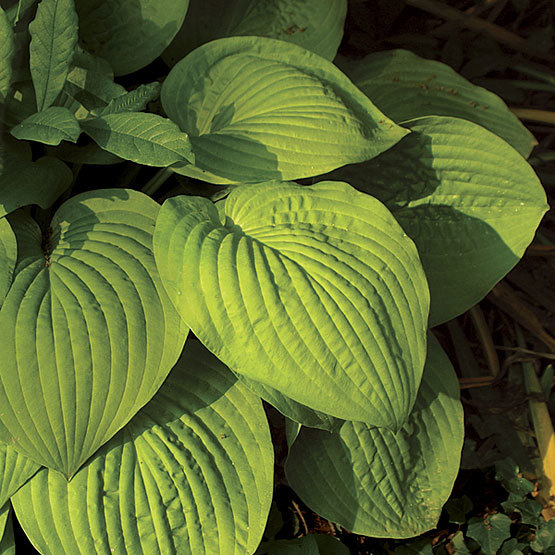
Roughly 70 species make up this genus of mostly clumping perennials. They are grown for their bold foliage, which may be variegated or in shades of green, yellow, or grayish blue. Variegation may be wide-margined, narrow-margined, or centrally marked. Leaves can be ovate, lance-shaped, rounded, or heart-shaped. Flowers are borne in racemes, mainly in summer. Hostas can be used as accent plants, as ground covers (even under some trees), in beds and borders, at waterside, or in rock gardens. Check out Showstopping Hostas for recommended varieties.
Distribution
Hostas are native to northeastern Asia, including parts of China, Korea, Japan, and Russia. In the wild, hostas often have solid green or bluish green foliage, and variegation is the result of a sport, or a genetic mutation. Many of the nearly 3,000 named varieties are the results of collected sports.
Noteworthy CharacteristicsThese plants are known for their ornamental, bold foliage. Tall scapes with trumpet-shaped flowers bloom anywhere from late spring to fall based on variety. Flowers may be fragrant and are purple, lavender, or white. Hostas are very hardy and somewhat drought tolerant. Miniature cultivars are available. These perennials grow from rhizomes, and some make good ground covers. They are toxic to dogs, cats, and horses.
CareHostas grow best in Zones 3–8. They need fertile, moist, well-drained soil. They can tolerate shade but perform best with full morning sun in northern areas and filtered shade in the south. Lighter or more variegated foliage should be exposed to slightly more sun, while darker-foliaged hostas should have more shade. Some varieties have been bred that can take full sun or full shade. Hostas are heavy feeders and benefit from soil amendments of organic matter.
PropagationThe easiest way to propagate hostas is to divide them, preferably in spring or fall. Their performance may benefit from division. If choosing to collect seed, know that many cultivars are sterile, and those that are not will not necessarily pass on their unique coloring to their offspring. Hostas grown by seed can look very different from their parents. If choosing to grow by seed, keep seeds moist in a warm, bright area.
ProblemsSlugs, snails, and cutworms are common problems. These can be effectively controlled through traps or nontoxic sprays. Viruses and foliar nematodes can also affect hostas; plants affected by these issues should be removed. Container-grown plants are vulnerable to vine weevil; diatomaceous earth and sticky traps can be effective against them. Hostas are a favorite plant of deer and may also be eaten by woodchucks, rabbits, and domestic ducks and chickens.































